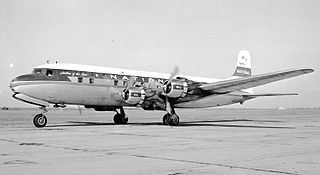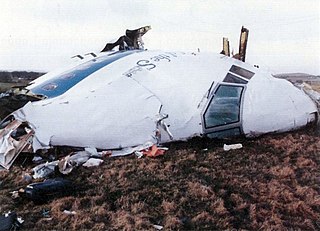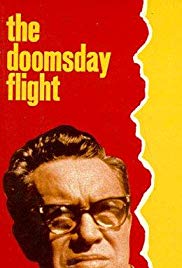
Trans World Airlines Flight 800 (TWA800) was a Boeing 747-100 that exploded and crashed into the Atlantic Ocean near East Moriches, New York, on July 17, 1996, at about 8:31 pm. EDT, 12 minutes after takeoff from John F. Kennedy International Airport, on a scheduled international passenger flight to Rome, with a stopover in Paris. All 230 people on board died in the crash; it is the third-deadliest aviation accident in U.S. history. Accident investigators from the National Transportation Safety Board (NTSB) traveled to the scene, arriving the following morning amid speculation that a terrorist attack was the cause of the crash. Consequently, the Federal Bureau of Investigation (FBI) and New York Police Department Joint Terrorism Task Force (JTTF) initiated a parallel criminal investigation. Sixteen months later, the JTTF announced that no evidence of a criminal act had been found and closed its active investigation.

John "Jack" Gilbert Graham was an American mass murderer who, on November 1, 1955, killed 44 people aboard United Airlines Flight 629 near Longmont, Colorado, using a dynamite time bomb. Graham planted the bomb in his mother's suitcase in an apparent move to murder her and claim $37,500 worth of life insurance money from policies he purchased in the airport terminal just before the flight departure. Graham was charged with and convicted of the murder of his mother. He was sentenced to death and was executed by the state of Colorado in January 1957.
This is a list of aviation-related events from 1955:
This is a list of aviation-related events from 1995:

United Airlines Flight 585 was a scheduled passenger flight on March 3, 1991 from Denver to Colorado Springs, Colorado, carrying 20 passengers and 5 crew members on board. The plane experienced a rudder hardover while on final approach to runway 35 at Colorado Springs Municipal Airport, causing the plane to roll over and enter an uncontrolled dive. All 25 people onboard were killed.

China Northern Airlines Flight 6136 (CBF6136/CJ6136) was a Chinese domestic passenger flight from Beijing Capital International Airport to Dalian Zhoushuizi International Airport. On May 7, 2002, the McDonnell Douglas MD-82 operating the flight crashed into the bay near Dalian shortly after the pilot reported "fire on board", killing all 103 passengers and 9 crew members. The cause of the fire was later determined to be arson.

Continental Airlines Flight 11, registration N70775, was a Boeing 707 aircraft which exploded in the vicinity of Centerville, Iowa, while en route from O'Hare Airport, Chicago, Illinois, to Kansas City, Missouri, on May 22, 1962. The aircraft crashed in a clover field near Unionville, in Putnam County, Missouri, killing all 45 crew and passengers on board. The investigation determined the cause of the crash was a suicide bombing committed as insurance fraud.

Cubana de Aviación Flight 455 was a Cuban flight from Barbados to Jamaica that was brought down on 6 October 1976 by a terrorist bomb attack. All 73 people on board the Douglas DC-8 aircraft were killed after two time bombs went off and the plane crashed into the sea. The crash killed every member of the Cuban national fencing team.

National Airlines Flight 2511 was a United States domestic passenger flight from New York City to Miami, Florida. On January 6, 1960, the Douglas DC-6 serving the flight exploded in midair. The National Airlines aircraft was carrying 5 crew members and 29 passengers, all of whom perished. The Civil Aeronautics Board investigation concluded that the plane was brought down by a bomb made of dynamite. No criminal charges were ever filed, nor was the blame for the bombing ever determined, though a suicide bombing is suspected. The investigation remains open.

United Airlines Flight 409 was a scheduled flight which originated in New York City, New York. The final flight destination was San Francisco, California, with stops in Chicago, Denver and Salt Lake City. The aircraft operating the service, a Douglas DC-4 propliner, registration N30062, crashed into Medicine Bow Peak, near Laramie, Wyoming, on October 6, 1955, killing all 66 people on board. The victims included five female members of the Mormon Tabernacle Choir and military personnel. At the time, this was the deadliest airline crash in the history of American commercial aviation. Another 66 lives had been lost earlier that year in the March 22 crash in Hawaii of a United States Navy Douglas R6D-1 Liftmaster military transport aircraft, and 66 had also died in the mid-air collision of two United States Air Force C-119G Flying Boxcars over West Germany on August 11, placing the three crashes in a three-way tie as the deadliest aviation incidents in 1955.

The FBI Story is a 1959 American drama film starring James Stewart, and produced and directed by Mervyn LeRoy. The screenplay by Richard L. Breen and John Twist is based on a book by Don Whitehead.

The investigation into the bombing of Pan Am Flight 103 began at 19:03 on December 21, 1988 when Pan Am Flight 103 was blown up over Lockerbie in Dumfries and Galloway, Scotland. The perpetrators had intended the plane to crash into the sea, destroying any traceable evidence, but the late departure time of the aircraft meant that its explosion over land left a veritable trail of evidence. The investigation led to the prosecution, conviction, and imprisonment of Abdelbaset al-Megrahi.

Joseph-Albert Guay was a Canadian mass murderer, who was involved in the bombing of Canadian Pacific Air Lines Flight 108, known as the Sault-au-Cochon Tragedy.

Pan Am Flight 103 was a regularly scheduled Pan Am transatlantic flight from Frankfurt to Detroit via a stopover in London and another in New York City. The transatlantic leg of the route was operated by Clipper Maid of the Seas, a Boeing 747-121 registered N739PA. Shortly after 19:00 on 21 December 1988, while the aircraft was in flight over the Scottish town of Lockerbie, it was destroyed by a bomb that had been planted on board, killing all 243 passengers and 16 crew in what became known as the Lockerbie bombing. Large sections of the aircraft crashed in a residential street in Lockerbie, killing 11 residents. With a total of 270 fatalities, it is the deadliest terrorist attack in the history of the United Kingdom.
TWA Flight 800 conspiracy theories are discredited alternative explanations of the crash of Trans World Airlines Flight 800 in 1996. The NTSB found that the probable cause of the crash of TWA Flight 800 was an explosion of flammable fuel/air vapors in a fuel tank, most likely from a short circuit. Conspiracy theories claim that the crash was due to a U.S. Navy missile test gone awry, a terrorist missile strike, or an on-board bomb. In 2013, a documentary alleging that the investigation into the crash was a cover-up made news headlines with statements from six members of the original investigation team, now retired, who also filed a petition to reopen the probe.

Pan Am Flight 7 was a westbound round-the-world flight operated by Pan American World Airways. On November 8, 1957, the Boeing 377 Stratocruiser 10-29 serving the flight, named Clipper Romance of the Skies, crashed in the Pacific Ocean enroute to Honolulu International Airport from San Francisco. The crash killed all 36 passengers and 8 crew members.
Craig David Button was a United States Air Force captain who died when he crashed a Fairchild A-10 Thunderbolt II aircraft under mysterious circumstances on 2 April 1997. During the incident, Captain Button inexplicably flew hundreds of miles off-course without radio contact, appeared to maneuver purposefully and did not attempt to eject before the crash. His death is regarded as a suicide because no other hypothesis explains the events. The incident caused widespread public speculation about Button's intentions and whereabouts until the crash site was found three weeks later. The aircraft carried live bombs which have not been recovered.
The Denver District Attorney's Office is responsible for the prosecution of state criminal violations in the Second Judicial District. Colorado has 64 counties within the 22 judicial districts in the State. The office is composed of approximately 75 attorneys and 125 support staff, who as a whole are responsible for more than 6,000 felony and 17,000 misdemeanor prosecutions annually. The elected District Attorney is the chief law enforcement officer in the City and County of Denver, and is responsible for the prosecution of violations of Colorado State Laws. The current Denver District Attorney is Beth McCann.

The Doomsday Flight is a 1966 television-thriller film written by Rod Serling and directed by William Graham. The cast includes Jack Lord, Edmond O'Brien, Van Johnson, Katherine Crawford, John Saxon, Richard Carlson and Ed Asner.















